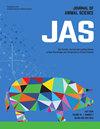131饲养场环境中雄鹿生长速率、胴体肌肉和寄生虫抗性的五年分析
IF 2.9
2区 农林科学
Q1 AGRICULTURE, DAIRY & ANIMAL SCIENCE
引用次数: 0
摘要
从2018年到2023年,在西弗吉尼亚大学对春季出生的Kiko雄鹿进行了性能测试,以评估人工感染下的生长速度、超声胴体特征和寄生虫抗性。Kiko bucks是由来自17个不同州的生产商提交的,进行了5次性能测试,评估了830只Kiko bucks。雄鹿分组饲养,饲喂含有16%大豆壳的CP颗粒,作为膳食纤维成分。雄鹿抵达后,要称重、接种疫苗、取样粪便,并使用三种不同类型的驱虫剂进行驱虫。2周过渡期后,开始63-d测试期。每隔12小时取测试体重的平均值。然后每周测量一次体重,直到非测试体重,最终的体重间隔12小时并取平均值。在试验开始、第21天、第42天和试验结束时进行粪便取样。在试验结束前1周,超声测量第12和第13肋界面的REA。到货重量、试验重量和最终重量逐年不变(P >;0.05)。5年平均分娩体重为24.29kg(±0.85kg),平均试重为27.11kg(±0.98kg),平均试重为39.01kg(±1.15kg),平均日增重为0.19 kg/d(±0.02kg/d)。REA 5年平均值为9.2cm2(±0.55cm2)。对于生产者报告,REA被调整为100磅体重,以消除个人体重偏差。调整后的REA (cm2/cwt) 5年平均值为10.86 cm2/cwt(±0.74 cm2/cwt)。在试验日,所有雄鹿口服5000只弯纹夜蛾幼虫,以评价其对寄生虫的抗性。5年平均试验粪蛋数(FEC)为195.89个/g(±85.60个/g)。在这5年中,大多数雄鹿没有发展出大的FEC,这使得在这种情况下评估寄生虫耐药性变得困难。尽管如此,这些数据提供了对饲养场环境中预期雄鹿性能的可靠评估,特别是在参考生长和胴体指标方面,对于生产者改进其畜群和美国其他性能试验站来说应该是一个有用的比较。本文章由计算机程序翻译,如有差异,请以英文原文为准。
131 Five-year analysis of Kiko buck growth rate, carcass muscling and parasite resistance in a feedlot environment
From 2018 to 2023, spring-born Kiko bucks were performance tested at West Virginia University to evaluate growth rate, ultrasound carcass characteristics and parasite resistance under an artificial infection. Kiko bucks were submitted by producers from 17 different states and over 5 performance tests, 830 Kiko bucks were evaluated. Bucks were group housed and fed 16% CP pellet containing soyhulls, serving as dietary fiber component. Upon arrival, bucks were weighed, vaccinated, fecal sampled and dewormed using three different classes of anthelmintic. After a 2-wk transition period, a 63-d test period began. On-test weights were taken 12 hours apart and averaged. Then weights were taken weekly until the off-test weight, where final weights were taken 12 hours apart and averaged. Fecal sampling occurred at on-test, 21d, 42d and off-test. Ultrasonic measurement of REA at the 12th and 13th rib interface was conducted 1 wk prior to test completion. Arrival weight, on-test weight and final weight did not vary by year (P > 0.05). 5-year average delivery weight was 24.29kg (±0.85kg), average on-test weight was 27.11kg (±0.98kg), average off-test weight was 39.01kg (±1.15kg) and ADG was 0.19 kg/d (±0.02kg/d). Analysis of REA revealed a 5-year average of 9.2cm2 (±0.55cm2). For producer reporting, REA was to adjusted to 100 lbs of body weight, to remove individual weight bias. Adjusted REA (cm2/cwt) 5-year average was 10.86 cm2/cwt (±0.74 cm2/cwt). To evaluate parasite resistance all bucks were orally administered 5,000 H. contortus larvae during on-test day. Average 5-year test fecal egg count (FEC) was 195.89 eggs/g (± 85.60 eggs/g). Across these 5 years, most bucks did not develop a large FEC making evaluation of parasite resistance difficult in this setting. Nonetheless these data provide a robust evaluation of expected Kiko buck performance in a feedlot setting, particularly in reference growth and carcass metrics and should be a useful comparison for producers to make improvement in their herds and for other performance test stations across the US.
求助全文
通过发布文献求助,成功后即可免费获取论文全文。
去求助
来源期刊

Journal of animal science
农林科学-奶制品与动物科学
CiteScore
4.80
自引率
12.10%
发文量
1589
审稿时长
3 months
期刊介绍:
The Journal of Animal Science (JAS) is the premier journal for animal science and serves as the leading source of new knowledge and perspective in this area. JAS publishes more than 500 fully reviewed research articles, invited reviews, technical notes, and letters to the editor each year.
Articles published in JAS encompass a broad range of research topics in animal production and fundamental aspects of genetics, nutrition, physiology, and preparation and utilization of animal products. Articles typically report research with beef cattle, companion animals, goats, horses, pigs, and sheep; however, studies involving other farm animals, aquatic and wildlife species, and laboratory animal species that address fundamental questions related to livestock and companion animal biology will be considered for publication.
 求助内容:
求助内容: 应助结果提醒方式:
应助结果提醒方式:


